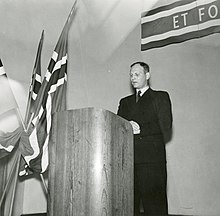Olaf Helset
Olaf Helset (born July 28, 1892 in Nannestad , † August 21, 1960 in Oslo ) was a Norwegian officer with the rank of major general and sports functionary . He played a leading role in the early resistance during the German occupation of Norway in World War II . After exile in Sweden , he was Commander-in-Chief of the Norwegian Army for two years . He also presided over the Norwegian Ski Association and the sports umbrella organization Norges idrettsforbund .
biography
He was the son of the teacher Peder Helset and Ingeborg Kristiane Skjegstad. Grew up in the Romerike region , Helset graduated from high school in Kristiania ( Oslo ) in 1911 . He was shaped politically by his membership in the left-wing nationalist youth organization Bondeungdomslaget. From 1912 he attended the Krigsskolen , from 1915 the state gymnastics school and from 1917 to 1919 the Norwegian military academy. In March 1920 he married the teacher Eugenie Hansen. He worked as an adjunct of the General Staff and passed the General Staff Examination in 1928. Study visits took him to France and Japan .
Helset also worked as a sports official. In the years 1917 to 1927 he presided over the Oslo association IL i BUL with several interruptions. He then served as Vice President of the Norwegian Ski Association and from 1930 to 1932 as its President. In 1928 and 1932 he was the team leader of the Norwegian cross-country skiers at the Olympic Winter Games in St. Moritz and Lake Placid . In 1929 and 1931, on behalf of the Japanese Ski Association, he designed two ski jumping hills in the city of Sapporo , the Araiyama ski jump and the Ōkurayama ski jump . In 1938/39 he was deputy commander of the 6th Infantry Regiment of the Norwegian Army .
During the invasion of Norway , Helset opposed the Wehrmacht with around 100 men in the battle of Midtskogen near Elverum on the night of April 9-10, 1940 . He was instrumental in enabling King Haakon VII and the government to flee the country. As a prisoner of war, he was sent to the Grini Police Detention Center , but was released three months later. Then he was one of the co-founders of the resistance organization Milorg . In public he appeared as chairman of the national sports umbrella organization Norges idrettsforbund (NIF), but had to give up this post after a short time after he had enforced an almost complete boycott of the Norwegian sports company, which lasted until the end of the war.
Helset was arrested on February 4, 1941, but after some time escaped from prison and fled to Sweden . There he was initially responsible for coordinating the refugees. In December 1943, the Swedish government allowed the creation of secret camps for the training of police forces who were recruited from among the Norwegian refugees. After the end of the war, which was now foreseeable, this was supposed to replace the police officers commanded by Vidkun Quisling's puppet government and arrest collaborators. Helset was the commander in chief of these police forces, who were also involved in the liberation of the Finnmark region from January 1945 .
After his return, Helset immediately resumed work at the NIF and was again its president from 1946 to 1948. In the same period he served as Commander in Chief of the Norwegian Army (as successor to Ole Berg ). Political differences of opinion with Defense Minister Jens Christian Hauge over the future direction of the military led to the resignation of both offices. The government then appointed Helset head of the Sørlandet district command with the rank of major general . From 1951 to 1953 he headed the Viken district command and the Fredriksten fortress . He was also President of the Organizing Committee of the 1952 Winter Olympics in Oslo.
For his services during the war, Helset received various awards, including the Norwegian War Cross , the Swedish Order of the Sword and the Finnish Order of the Freedom Cross ; he was also commander of the French Legion of Honor . In the Antarctic, the Helsetskarvet mountain region bears his name.
Web links
- Jon Gunnar Arntzen: Article Olaf Helset in Norsk biografisk leksikon
Individual evidence
- ^ Olaf Almenningen, Alv Reidar Dale, Lars S. Vikør: "Og byen er vår bror ..." Bondeungdomslaget i Oslo 1899-1989 . Det Norske Samlaget, Oslo 1989, ISBN 978-82-521-3461-2 , pp. 280 .
- ↑ Ōkurayama. skisprungschanzen.com, accessed on September 22, 2018 .
- ↑ Araiyama. skisprungschanzen.com, accessed on September 22, 2018 .
- ↑ Per Voksø: Krigens Dagbok . Det Beste, Oslo 1984, ISBN 82-7010-166-4 , pp. 530 .
| personal data | |
|---|---|
| SURNAME | Helset, Olaf |
| BRIEF DESCRIPTION | Norwegian army officer and sports official |
| DATE OF BIRTH | July 28, 1892 |
| PLACE OF BIRTH | Nannestad |
| DATE OF DEATH | August 21, 1960 |
| Place of death | Oslo |
